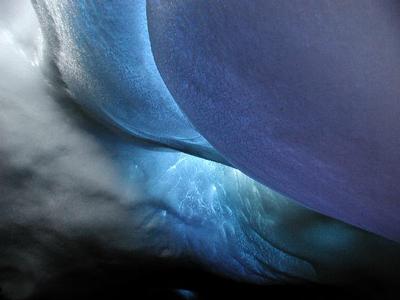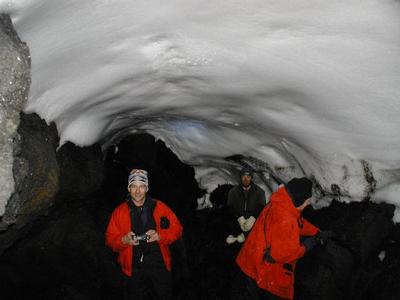8 December, 2001
Yesterday the idea of using the sense of sight was considered as one
avenue by which this research team is attempting to understand the
volcano. Before we consider the sense of smell, I would like to establish
a few basic ideas that might help to make clear what we're doing here.
First, therre is no single hypothesis--no overriding thesis that is being
tried. Mt. Erebus is a "well-behaved" (yet far >from asleep) volcano that
offers a relatively unique window of opportunity for all kinds of
vulcanological research. There is certainly the idea that a volcano like
this allows geologists to see into the earth--a rare opportunity--but the
questions being asked are varied. In some ways, this is not a team. It
will generate several papers, not one integrated work. In other ways--the
work ways--it is definitely a team, with everyone helping someone else
many different times.
One more thing to keep in mind as we proceed, is that there is a
student/teacher relationship going on here. Graduate and undergraduate
students working with University professors to establish their own cache
of data, ideas for publishing, and a sense of "how-to" when it comes to
actually doing research in this harsh place.
Smell can send a powerful signal. I won't go on about how repugnant,
overwhelming, beautiful, or confusing a smell can be--we all know. But
what about "smelling" a volcano? I can say at the outset that it
stinks! Smelling involves making sense of molecules that are dispersed
into the air. If Mt.Erebus can be smelled, than it must be emitting gases
into the air, and indeed it is. Some of the gases are perhaps easily
guessed. Let's start with water vapor. It is the "big boy" of gases
emitted in the plume. If you are following me so far, then you are
probably familiar with the water cycle. The water you pour into a glass
might contain molecules from ocean waves, icicles hanging from roofs, and
the vapor from the breath of your cat. The water vapor coming from Mt.
Erebus is brand new to the cycle! It has been "locked up" in the earth
from its formation, so Happy Birthday to this new water.
Second in line comes carbon dioxide. Tina Calvin hopes to measure carbon
dioxide during this field season. This is a chemical that interests
scientists for one overriding reason--global warming. Carbon dioxide
appears to help the earth hold its heat, thus changing its climate.
Vulcanologists would like to compare the amount of carbon dioxide emitted
by volcanoes to the carbon dioxide given off by people in all their many
activities (burning, driving, etc.).
Next comes a compound called sulfur dioxide. Sulfur appears leaching out
of the sides of the volcano, it can be found in pure lumps, it combines in
the atmosphere to form sulphuric acid--it does all sorts of things. (It's
the reason I said that the volcano can stink.) The way that it gets
measured as a gas is unique. For every other parameter, we are driving
snowmobiles all over the place, carting solar panels up hills, mailing
filters off to Paris....sheesh. Measuring sulphur dioxide is done >from
the hut. Dr. Philip Kyle aims his Correlation Spectrometer (COSPEC) at
the plume of the volcano on a "good day." It sweeps back and forth
through the plume telescopically. It is amazing to me that TONS of sulphur
are emitted into the atmosphere by this volcano every day. And this
volcano pales in comparison to others.
The idea that this volcano pales in comparison to other volcanoes is an
interesting story. It is not as big as other volcanoes. It doesn't "blow
up" quite as hugely as volcanoes in history have done. But here it sits
in such a pristine place bubbling and fuming away. A perfect specimen for
the vulcanologist.
This brings us to the last ingredients blasted into the atmosphere by this
hole in the earth. Elements like chlorine, fluorine, and then the
metals--lead, selenium, and others. Scientists are looking at levels of
lead found in the East Antarctic Ice Sheet. Minute levels, but the
question is, "Does this come from humans?" Maybe it comes from Mt.
Erebus? There are so many questions.
Personal log: Beautiful day. Twenty degrees below zero, but calm and
sunny. I made a run back to Fang Glacier to look for the big snow
crystals, but no luck. I also joined our visitors from the Exploratorium
for a brief descent into one of the ice fumeroles behind our camp.
Tomorrow: A trip to CONZ.

On the way out; the blue through the ice is beautiful.

The ice cave we entered. This has to be done carefully. It was a tight squeeze, the footing was bad, and the area around ice fumeroles can be dangerous. That's why I'm being careful. I went with Matt, our trusty guide.

Noel, Matt, and Paul with me underground (underice). It is warm and humid. Maybe the next time we get a wicked storm I'll sleep down here!
Contact the TEA in the field at
.
If you cannot connect through your browser, copy the
TEA's e-mail address in the "To:" line of
your favorite e-mail package.
|
